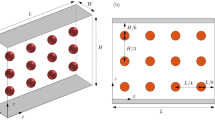Abstract
Recent work has shown that suspensions of highly thermally conducting nanoparticles with a size considerably smaller than 100 nm have great potential as a high-energy carrier for small channel systems. However, it is also known that particles in a suspension under certain conditions may migrate. This indicates that the efficiency of heat transfer in the small channels may not be as superior as expected, which bears significance to the system design and operation. This work aims at addressing this issue by examining the effect of particle migration on heat transfer under a fully developed laminar flow regime in small channels. This involves the development of both flow and heat transfer models, and a numerical solution to the models. The flow model takes into account the effects of the shear-induced and viscosity-gradient-induced particle migration, as well as self-diffusion due to Brownian motion, which is coupled with an energy equation. The results suggest a significant non-uniformity in particle concentration and, hence, thermal conductivity over the tube cross-section due to particle migration, particularly for large particles at high concentrations. Compared with the constant thermal conductivity assumption, the non-uniform distribution due to particle migration leads to a higher Nusselt number, which depends on the Peclet number and the mean particle concentration. Further improvement of the model is needed to take into account other factors such as entrance effects, as well as the dynamics of particles and particle–wall interactions.







Similar content being viewed by others
References
Ahuja AS (1975) Augmentation of heat transport in laminar flow of polystyrene suspensions II. Analysis of the data. J Appl Phys 46:3417–3425
Batchelor GK (1977) The effect of Brownian motion on the bulk stress in a suspension of spherical particles. J Fluid Mech 83:97–117
Cheng NS, Law AWK (2003) Exponential formula for computing effective viscosity. Powder Technol 129:156–160
Choi SUS (1995) Enhancing thermal conductivity of fluids with nanoparticles. In: Siginer DA, Wang HP (eds) Developments and applications of non-Newtonian flows. FED vol 231, MD vol 66. ASME Press, New York, pp 99–105
Das SK, Putra N, Roetzel W (2003) Pool boiling characteristics of nanofluids. Int J Heat Mass Transfer 46:851–862
Eastman JA, Choi SUS, Li S, Soyez G, Thompson LJ, Di Melfi D (1999) Novel thermal properties of nanostructured materials. Mater Sci Forum 312–314:629–634
Hetsroni G, Mosyak A, Segal Z (2001) Nonuniform temperature distribution in electronic devices cooled by flow in parallel microchannels. IEEE Trans Components Packag Technol 24:16–23
Keblinski P, Phillpot SR, Choi SUS, Eastman JA (2002) Mechanisms of heat flow in suspensions of nano-sized particles (nanofluids). Int J Heat Mass Transf 45:855–863
Lee S, Choi S, Li S, Eastman J (1999) Measuring thermal conductivity of fluids containing oxide nanoparticles. J Heat Transf 121:280–289
Leighton D, Acrivos A (1987) The shear-induced migration of particles in concentrated suspensions. J Fluid Mech 181:415–439
Liu S (1999) Particle dispersion for suspension flow. Chem Eng Sci 54:873–891
Masuda H, Ebata A, Teramae K, Hishinuma N (1993) Alteration of thermal conductivity and viscosity of liquid by dispersing ultra-fine particles (Dispersion of γ-Al2O3, SiO2 and TiO2 ultra-fina particles). Netsu Bussei (Japan) 4:227–233
Morris JF, Brady JF (1998) Pressure-driven flow of a suspension: buoyancy effects. Int J Multiphase Flow 24:105–130
Pak BC, Cho YI (1998) Hydrodynamics and heat transfer study of dispersed fluids with submicron metallic oxide particles. Exp Heat Transf 11:151–170
Phillips RJ, Armstrong RC, Brown RA, Graham AL, Abbott JR (1992) A constitutive equation for concentrated suspensions that accounts for shear-induced particle migration. Phys Fluids A 4:30–40
Russel WB, Saville DA, Schowalter WR (1991) Colloidal dispersions. Cambridge University Press, New York
Sohn CW, Chen MM (1981) Microconvective thermal conductivity in disperse two-phase mixtures as observed in a low velocity Couette flow experiment. J Heat Transf 103:47–51
Sohn CW, Chen MM (1984). Heat transfer enhancement in laminar slurry pipe flow with power law thermal conductivities. J Heat Transf 106:539–542
Tohver V, Chan A, Sakurada O, Lewis JA (2001) Nanoparticle engineering of complex fluid behavior. Langmuir 17:8414–8421
Wang BX, Zhou LP, Peng XF (2003) A fractal model for predicting the effective thermal conductivity of liquid with suspension of nanoparticles. Int J Heat Mass Transf 46:2665–2672
Wen DS, Ding YL (2004) Experimental investigation into convection heat transfer of nanofluids at the entrance region under laminar flow conditions. Int J Heat Mass Transf 28:5181–5188
Wen DS, Kenning DBR (2004) Two-phase pressure drop of water during flow boiling in a vertical narrow channel. Exp Therm Fluid Sci 28:131–138
Wen DS, Kenning DBR, Yan YY (2002) Flow of boiling water in a narrow vertical channel at low mass flux: observations of local phenomena. In: Proceedings of the 12th international heat transfer conference (IHTC’12), Grenoble, France, August 2002
Xie H, Wang J, Xi T, Liu Y, Ai F (2002) Thermal conductivity enhancement of suspensions containing nanosized alumina particles. J Appl Phys 91:4568–4572
Xuan Y, Li Q (2003) Investigation on convective heat transfer and flow features of nanofluids. J Heat Transf 125:151–155
Xuan Y, Roetzel W (2000) Conceptions for heat transfer correlations of nanofluids. Int J Heat Mass Transf 43:3701–3707
Author information
Authors and Affiliations
Corresponding author
Rights and permissions
About this article
Cite this article
Wen, D., Ding, Y. Effect of particle migration on heat transfer in suspensions of nanoparticles flowing through minichannels. Microfluid Nanofluid 1, 183–189 (2005). https://doi.org/10.1007/s10404-004-0027-2
Received:
Accepted:
Published:
Issue Date:
DOI: https://doi.org/10.1007/s10404-004-0027-2




